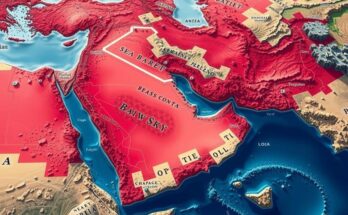Over the past week, intensified Israeli strikes led to the deaths of seven high-ranking Hezbollah officials, including leader Hassan Nasrallah. This escalation has shocked Lebanon and the Middle East, as Hezbollah faces significant losses in leadership and military capabilities amid ongoing hostilities with Israel. The situation raises questions about the future of the organization and its strategic objectives in the region.
In a recent surge of violence, Israeli military operations have resulted in the deaths of seven high-ranking officials from the Hezbollah militant organization over the course of a week. This unprecedented event has sent shockwaves throughout Lebanon and the broader Middle Eastern region, as Israeli authorities rejoice over considerable military successes. The conflict escalated following Hezbollah’s engagement in support of its ally, Hamas, in the aftermath of a surprise Hamas attack on southern Israel. The assassinations mark a notable intensification in the ongoing hostilities, particularly between Israel and Hezbollah, which significantly impacts the fragile political and military landscape of Lebanon. Prominent among those slain was Hassan Nasrallah, the longstanding leader of Hezbollah, who had guided the group since 1992 through numerous conflicts with Israel. Under his leadership, Hezbollah evolved into a dominant force within both Lebanese politics and regional military engagements, notably bolstering President Bashar Assad’s regime during the Syrian civil war. Nasrallah’s influence was polarizing; he was revered by some for his role in liberating southern Lebanon but criticized by others for his unilateral decision-making that many viewed as aligned with Iranian interests. Other notable figures killed included Nabil Kaouk, the deputy leader of Hezbollah’s Central Council, and Ibrahim Akil, a top commander responsible for the group’s elite Radwan Forces. They were accompanied by Ahmad Wehbe, Ali Karaki, Mohammad Surour, and Ibrahim Kobeissi, all of whom held critical positions that influenced Hezbollah’s military strategies. The deaths of these individuals represent severe setbacks for Hezbollah, especially given their long-held roles in the organization since its inception in the early 1980s. In light of these events, attention now shifts to the future of Hezbollah’s leadership. Naim Kassem, Nasrallah’s second-in-command, stands as the most senior surviving figure, while Hashim Safieddine, viewed as a potential successor, also emerges as a key player in the organization’s hierarchy. The ramifications of these targeted killings are profound, as they may alter Hezbollah’s operational capabilities and command structure in the face of ongoing Israeli counteractions.
The recent assassinations of high-ranking Hezbollah officials underscore the volatile nature of the Middle Eastern conflict, particularly in the context of Israeli-Hezbollah relations. Over the past weeks, escalated military strikes have dramatically shifted the balance of power, revealing vulnerabilities within Hezbollah, a potent paramilitary and political group in Lebanon. Historically, Hezbollah has been a significant player in regional conflicts affecting Lebanon, Syria, Iraq, and Yemen, often operating under the aegis of Iranian influence. The death of leaders such as Hassan Nasrallah and Nabil Kaouk significantly alters Hezbollah’s command structure, posing challenges for its continued effectiveness and strategic objectives in the region. The assassination of Nasrallah, in particular, is a pivotal moment, as he had been a central figure in the group’s operations and ideology for over three decades.
The recent assassinations of seven high-ranking Hezbollah officials, including its leader Hassan Nasrallah, mark a key escalation in the ongoing conflict between Israel and Hezbollah. The significant loss of leadership within Hezbollah is expected to impact its military capabilities and strategic direction. As the region braces for potential consequences, the remaining top officials, including Naim Kassem and Hashim Safieddine, face immense pressure to navigate this crisis while maintaining Hezbollah’s influence in the region. The outcome of this conflict has broader implications for regional stability and the ongoing rivalry between opposing factions.
Original Source: www.nbcphiladelphia.com




